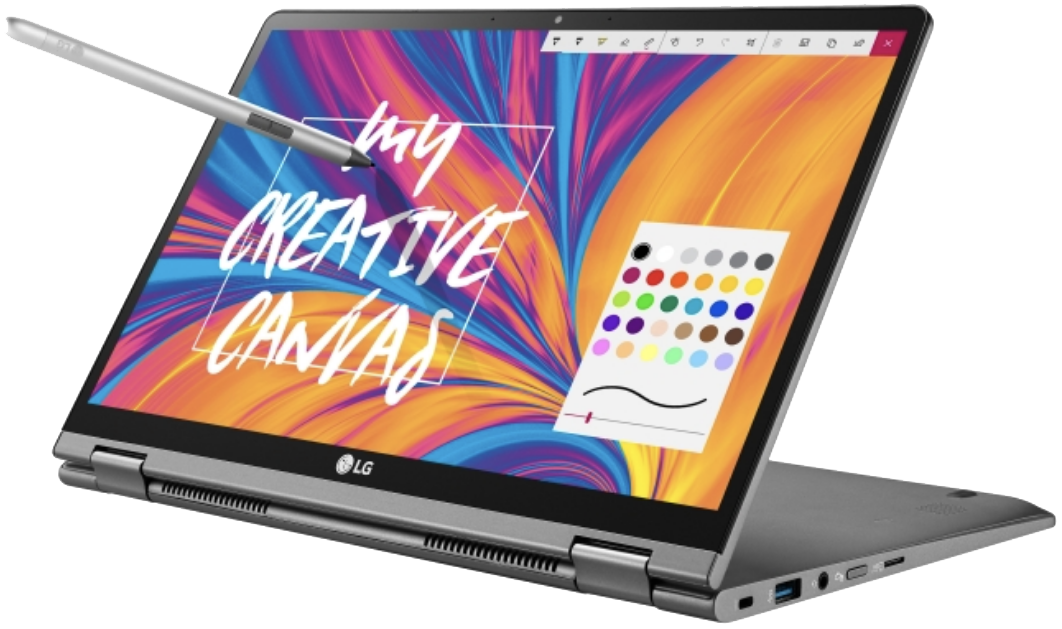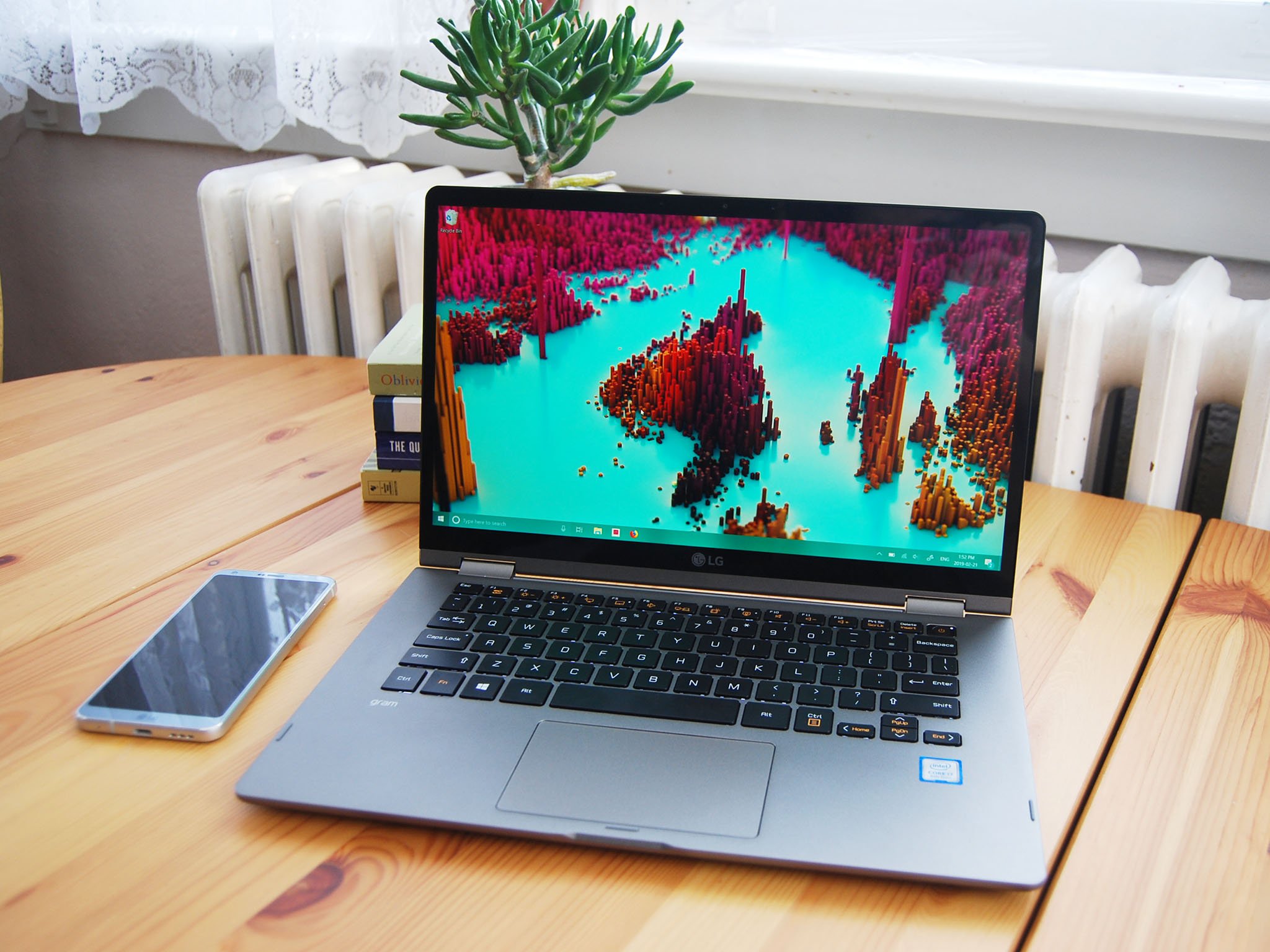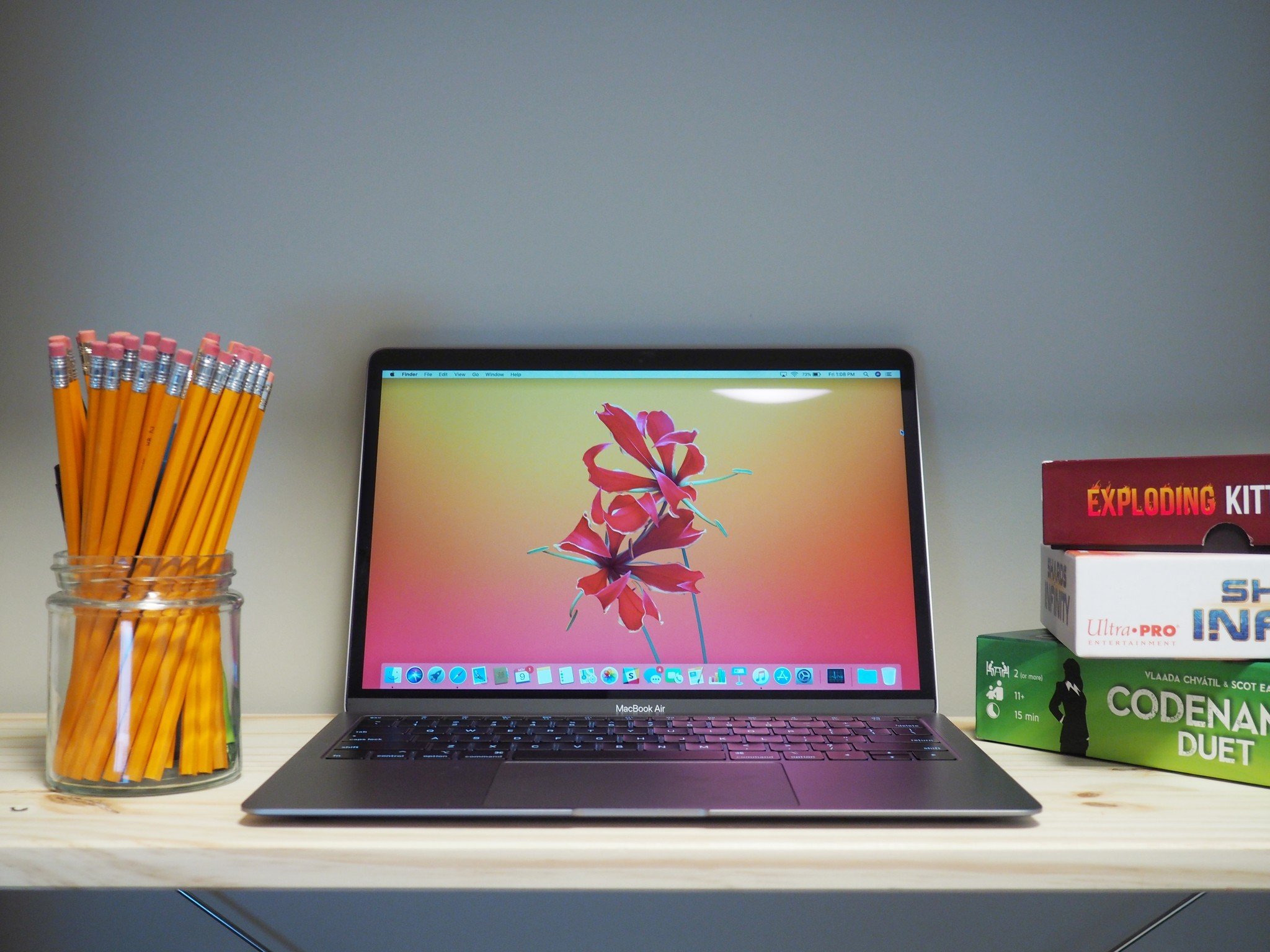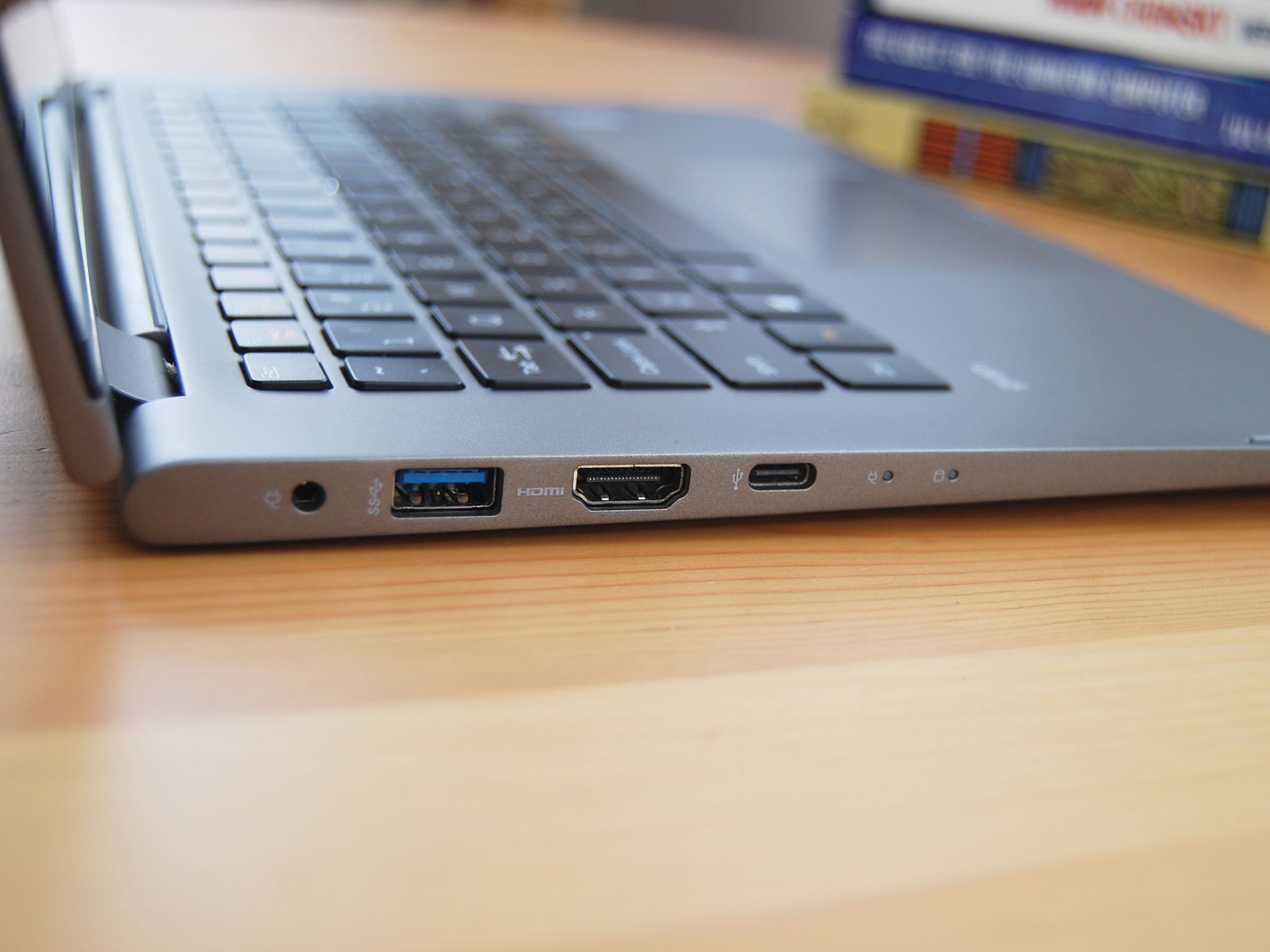LG gram 14 2-in-1 vs. MacBook Air: Which should you buy?
We get to to test and review a ton of laptops here at Windows Central, and we're comfortable recommending hardware that fits your needs. The LG gram 14 2-in-1 and MacBook Air are both lightweight and portable, but there are some major differences you should know about before making a final decision.


Lightweight convertible computing
LG's gram 14 2-in-1 is a 14-inch convertible laptop that weighs in at just 2.5 pounds, which is lighter than the MacBook Air. It has a generous port selection, an outstanding keyboard, and strong performance thanks to an 8th Gen Intel Core i7-8565U processor (CPU). However, the SATA solid-state drive (SSD) is slow, the touchpad is small, and you only get one buying option.
Pros
- Light, premium build
- All-day battery life
- Plenty of ports
- Superb keyboard
- Colorful touch display with pen
- Strong performance
Cons
- Slow storage
- Small touchpad
- One configuration available

Sleek, slim notebook
The 13.3-inch MacBook Air brings a high-res Retina display, slim aluminum body, huge touchpad, and a few configurations to help you get what you want, including color options. It is, however, held back by a less-powerful Y-series Intel CPU, mediocre keyboard with not much travel, and limited port selection that will leave you reaching often for a dongle.
Pros
- Beautiful Retina display
- Slim, sleek chassis
- Large, precise touchpad
- Touch ID fingerprint sensor
- Cheaper starting price
- All-day battery
Cons
- Limited port selection
- Shallow keyboard travel
- Y-series Intel processor
These two laptops are both undeniably light and built to a high-quality standard, and choosing between the two will likely depend on which OS you prefer rather than strictly hardware. From the latter viewpoint, the gram is going to offer better performance and more ports at a higher price, while the MacBook Air delivers a superior display (though non-touch) and a touchpad that's hard to beat.
LG gram 14 2-in-1 vs. MacBook Air tech specs
| Header Cell - Column 0 | LG gram 14 2-in-1 | MacBook Air |
|---|---|---|
| OS | Windows 10 Home | macOS |
| Processor | 8th Gen Quad-core Intel Core i7-8565U 1.8 GHz clock Up to 4.60 GHz | 8th Gen Dual-core Intel Core i5-8210Y 1.6 GHz clock Up to 3.6 GHz |
| RAM | 16 GB DDR4 | 8 GB LPDDR3 |
| Storage | 512 GB SATA3 SSD | 128, 256 GB PCIe SSD |
| Display size | 14 inches, touch | 13.3 inches, non-touch |
| Display resolution | 1,920 x 1,080, IPS | 2,560 x 1,600, IPS |
| Aspect ratio | 16:9 | 16:10 |
| Graphics | Intel UHD Graphics 620 | Intel UHD Graphics 617 |
| Ports | HDMI USB-C 3.1 Two USB-A 3.1 microSD card reader 3.5 mm audio | Two Thunderbolt 3 3.5 mm audio |
| Biometrics | Fingerprint reader | Fingerprint reader |
| Battery | 72 Wh | 50.3 Wh |
| Dimensions | 12.8 inches x 8.3 inches x 0.7 inches (325.12 mm x 210.82 mm x 17.78 mm) | 11.97 inches x 8.36 inches x 0.16 - 0.61 inches (304.1 mm x 212.4 mm x 0.41 - 1.56 mm) |
| Weight | 2.53 pounds (1.15 kg) | 2.75 pounds (1.25 kg) |
Lightweight convertible vs. lightweight notebook
Despite having a slightly larger footprint and more thickness than the MacBook Air, the LG gram's magnesium alloy chassis keeps it incredibly light at just 2.53 pounds. The MacBook Air, weighing in at 2.75 pounds, isn't exactly a heavyweight either, and you shouldn't have any issue tucking either laptop into a backpack or sleeve when you leave your home or office. The MacBook's all-aluminum design is a bit more rigid than the gram's chassis and seems a bit sleeker, and it is available in three colors — gold, silver, and space gray — while the gram comes in silver only.
The gram has a dual hinge setup that lets the display rotate around for tent, stand, and tablet modes, lending plenty of flexibility to how you use your device, especially with the included active pen. It's not necessary to use it as anything other than a notebook, but for some, it's nice to have the option. The MacBook Air, on the other hand, is strictly a notebook that doesn't use a touch display. For a lot of people that's just fine, but if you want something that can double as a tablet, you'll want to stick with the gram.
Both laptops have fingerprint readers built into the keyboard space (Apple includes its T2 security chip for holding Touch ID data), giving you a safer and more convenient way to log in and authenticate in certain apps. The latest MacBook Air has a redesigned keyboard with butterfly switches that many long-time Apple users find inferior to the previous option. It has very short key travel — a symptom of just about any laptop this thin — and it's loud when typing. The Air's Force Touch touchpad is, however, one of its best features. It's enormous in relativity to the rest of the laptop, it tracks precisely, and it can be clicked the same in any spot, even along the edges and top.
The gram is sort of the opposite when it comes to input, as the keyboard is outstanding but the touchpad is just OK. Typing is soft, quiet, and smooth, and there's plenty of key travel. I used it a lot during the review process, and I'd take it over just about any other keyboard out there. The touchpad, though, is kind of small and a bit flimsy. Clicking is soft and tracking is spot on thank to Microsoft's Precision drivers, but it loses in direct comparison to the MacBook Air.
No doubt due mostly to its thinness, the MacBook Air sports just two Thunderbolt 3 ports and a 3.5 mm audio jack. Both Thunderbolt 3 ports offer four lanes of PCIe (40 Gbps) for superb performance, whether you're looking to connect external displays or an external graphics card (eGPU). The lack of variety does mean you'll want to invest in some dongles, a problem that the gram mitigates thanks to a wider selection. LG's laptop comes with HDMI, USB-C 3.1 (unfortunately no Thunderbolt 3), two USB-A 3.1 for legacy devices, a microSD card reader for quick file transfer, and a 3.5 mm audio jack.
Bottom line? If you'd like a convertible laptop that can be used as a tablet or a notebook, you really only have one choice in the LG gram 14 2-in-1. It also has better port selection, it's lighter, and its keyboard is superior. If you don't mind sticking with a strict notebook design, the MacBook Air brings a superior touchpad, a smaller overall footprint, and dual Thunderbolt 3 connectivity.
All the latest news, reviews, and guides for Windows and Xbox diehards.
Higher resolution or touch functionality in a display?
Apple's Retina displays are admittedly gorgeous, including the 13.3-inch non-touch screen on the MacBook Air. It uses an IPS panel for wide viewing angles, it has a 16:10 aspect ratio, and it brings a 2,560 x 1,600 resolution for a crisp picture. It hits 97 percent sRGB and 62 percent AdobeRGB color reproduction, which are both respectable results. The bezel is much thinner than on the old Air models, bringing together an all-around satisfying viewing experience. If you're interested in touch functionality, however, you'll have to go with the gram.
LG's laptop has a larger 14-inch touch display that too uses an IPS panel for wide viewing angles, but its resolution caps out at 1,920 x 1,080 with no option for an upgrade. It has thin bezels and excellent color reproduction (99 percent sRGB and 77 percent AdobeRGB) for a colorful picture. Every gram comes with an active pen based on Wacom AES 2.0 technology, which brings 4,096 levels of pressure sensitivity and tilt support. If you have some creative ambition or just want a device you can use to jot down notes, the gram 14 2-in-1 is the better choice.
Performance and price


The MacBook Air starts at about $1,099 for a configuration with an 8th Gen Intel Core i5-8210Y CPU, 8 GB of LPDDR3 RAM, and a small but fast 128 GB PCIe SSD. If that doesn't seem like enough storage, you can upgrade to a model with a 256 GB PCIe SSD, which raises the price by about $200. That's a hefty sum for an extra 128 GB, and you're still stuck with a relatively lightweight Y-series CPU. It has two cores and a base clock of 1.60 GHz, making it better suited for regular productivity tasks than anything heavy. Geekbench 4 single-core scores usually sit between 4,000 and 4,500 and multi-core scores sit between 7,000 and 8,000.
The gram 14 2-in-1 has just one configuration available for about $1,500, complete with a Whiskey Lake 8th Gen Intel Core i7-8565U CPU, 16 GB of DDR4 RAM, and a 512 GB SATA3 SSD. Storage read and write speeds definitely pale in comparison to the PCIe SSD in the MacBook Air, but otherwise, you'll get superior performance in the gram.
The Core i7 CPU has four cores and a base clock of 1.8 GHz, making it better suited for a wider range of tasks and heavier multitasking. In my testing, it hit a 4,829 single-core score and a 13,889 multi-core score in Geekbench 4. Superior performance does come at a price, though, and not everyone can drop $1,500, making the Air's entry price of $1,099 much more attractive.
LG gram 14 2-in-1 is a lightweight, powerful convertible
If you like the idea of a touch laptop that can fold around into a tablet, the LG gram 14 2-in-1 is really your only choice. It costs more than the entry MacBook Air, but it will deliver superior performance, more ports, an outstanding keyboard, and active pen compatibility.

Outstanding convertible with a lightweight chassis
LG's gram 14 2-in-1 takes a good thing and makes it convertible, bringing some necessary changes along the way. Active pen support is solid, the display is vivid, the magnesium alloy chassis can put up with daily abuse, and it's light enough that you'll hardly notice it's with you. Configurations are, however, limited, and it costs more than the MacBook Air.
The MacBook Air is a worthwhile notebook laptop
It might not be as powerful as the gram, but its high-res display is outstanding, it's thinner and has a slightly smaller footprint, the touchpad is big and a pleasure to use, and it starts at a cheaper price. As long as you don't mind using macOS, it's a great all-around device.

Ridiculously thin productivity machine
The MacBook Air brings a small footprint, high-res display, and premium build quality, all in a sleek aluminum chassis. It might not be as light as the gram and it might not offer the same performance, but it's still a knockout for anyone who needs an ultraportable laptop for productivity purposes.

Cale Hunt brings to Windows Central more than nine years of experience writing about laptops, PCs, accessories, games, and beyond. If it runs Windows or in some way complements the hardware, there’s a good chance he knows about it, has written about it, or is already busy testing it.




